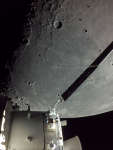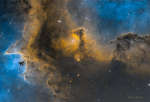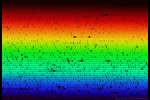
|
Astronomy Picture Of the Day (APOD)
 APOD: 2025 December 15 Б Gemini Meteors over Snow Capped Mountains
APOD: 2025 December 15 Б Gemini Meteors over Snow Capped Mountains
14.12.2025
Where are all of these meteors coming from? In terms of direction on the sky, the pointed answer is the constellation of Gemini. That is why the major meteor shower in December is known as the Geminids -- because shower meteors all appear to come from a radiant toward Gemini.
 APOD: 2025 December 14 Б Juno Flyby of Ganymede and Jupiter
APOD: 2025 December 14 Б Juno Flyby of Ganymede and Jupiter
13.12.2025
What would it be like to fly over the largest moon in the Solar System? In 2021, the robotic Juno spacecraft flew past Jupiter's huge moon Ganymede and took images that have been digitally constructed into a detailed flyby.
 Orion and the Ocean of Storms
Orion and the Ocean of Storms
12.12.2025
On December 5, 2022, a camera on board the uncrewed Orion spacecraft captured this view as Orion approached its return powered flyby of the Moon. Beyond one of Orion's extended solar arrays lies dark, smooth, terrain along the western edge of the Oceanus Procellarum.
 Northern Fox Fires
Northern Fox Fires
11.12.2025
In a Finnish myth, when an arctic fox runs so fast that its bushy tail brushes the mountains, flaming sparks are cast into the heavens creating the northern lights. In fact the Finnish word "revontulet", a name for the aurora borealis or northern lights, can be translated as fire fox.
 Galaxies in the River
Galaxies in the River
10.12.2025
Large galaxies grow by eating small ones. Even our own galaxy engages in a sort of galactic cannibalism, absorbing small galaxies that are too close and are captured by the Milky Way's gravity.
 The Horsehead Nebula
The Horsehead Nebula
9.12.2025
Sculpted by stellar winds and radiation, this dusty interstellar molecular cloud has by chance has assumed an immediately recognizable shape. Fittingly known as The Horsehead Nebula, it lies some 1,500 light-years distant, embedded in the vast Orion cloud complex.
 APOD: 2025 December 9 Б The Heart of the Soul Nebula
APOD: 2025 December 9 Б The Heart of the Soul Nebula
8.12.2025
This cosmic close-up looks deep inside the Soul Nebula. The dark and brooding dust clouds outlined by bright ridges of glowing gas are cataloged as IC 1871. About 25 light-years across, the telescopic field of view spans only a small part of the much larger Heart and Soul nebulae.
 APOD: 2025 December 8 Б Flying Over the Earth at Night
APOD: 2025 December 8 Б Flying Over the Earth at Night
7.12.2025
Many wonders are visible when flying over the Earth at night. Such visual spectacles occur every day for astronauts in low Earth orbit, but the featured video captured several from the International Space Station (ISS) in 2011 and set them to rousing music.
 APOD: 2025 December 7 Б The Sun and Its Missing Colors
APOD: 2025 December 7 Б The Sun and Its Missing Colors
6.12.2025
It is still not known why the Sun's light is missing some colors. Here are all the visible colors of the Sun, produced by passing the Sun's light through a prism-like device.
 Apollo 17 at Shorty Crater
Apollo 17 at Shorty Crater
5.12.2025
Fifty three years ago, in December of 1972, Apollo 17 astronauts Eugene Cernan and Harrison Schmitt spent about 75 hours on the Moon exploring the Taurus-Littrow valley, while colleague Ronald Evans orbited overhead. This snapshot from another world was taken by Cernan as he and Schmitt roamed the lunar valley's floor.
|
January February March April May June July August September October November December |
|||||||||||||||||||||||||||||||||||||||||||||||||